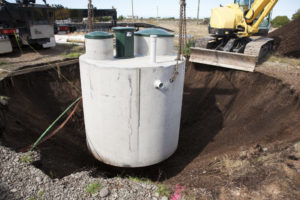
You may need to locate your septic tank if you’re experiencing specific plumbing issues. Here are some steps to doing so.
Whether you’ve moved onto a new property or just bought a new house, many people actually have trouble locating their septic tank. New homeowners especially can find it difficult to navigate the inner workings of a house, but it’s important to know where your septic tank is located in order to have it properly serviced and to avoid issues with your home down the line. It’s also important to know where your septic tank is when you plan new landscaping or plant a garden. Here are our tips for determining where your septic tank is located.
Look Around the Yard
It may seem like a simple first step, but on a large property, just looking for your septic tank can seem like a tall task. But finding a tank on a large property doesn’t have to be like finding a needle in a haystack. There are plenty of areas in your lawn you can rule out, such as areas near structures, paved surfaces, large trees, and the water well. If you notice a greener area of grass, or a patch of grass that grows more quickly than the rest of your lawn, this can also be an indicator of your tank’s location.
Check Public Records
If you’re having a lot of trouble locating the septic tank on your new property, your county or municipality may have public records indicating its location. Your local records office will have the right maps for you to find your septic tank’s location, as well as its dimensions. You may also be able to find the location of your septic tank in the home inspection report, so be sure to check your paperwork thoroughly when you start the search for your tank.
Follow the Sewer Pipes
A good place to start is actually the basement. From the basement, you can find the sewer pipe that exits your home. This will give you a good starting point to finding your septic tank. Go outside to the other side of the wall with a metal soil probe, probing periodically in order to follow the sewer pipe, eventually leading you to the septic tank.
Find the Septic Tank Lid
Once you find the location of your septic tank, you will still need to dig up the lid. This is where soil probes can be very useful. Probe the area where your tank is located in order to determine the perimeter of the tank. Most tanks will be about 5 feet x 7 feet. Once you lay out the perimeter with the probe, you can start digging at the center to find the septic tank lid.
Call Mahon Plumbing Today
If you’re ready to see how an upgrade can help your home, the experts at Mahon plumbing are here to help. Mahon Plumbing has been serving the Baltimore region’s plumbing needs since 1994. We’re ready to offer quality plumbing services and gas installation for both commercial and residential uses. Our tracks and employees are ready to handle the toughest of jobs.
For more information, follow our blog or check us out on Facebook or Twitter. We’re able to offer 24 hours a day, 7 days a week emergency services. Please contact our Baltimore location at 410-766-8566 and our Pasadena location at 410-636-7944 if you have any questions or are in need of emergency services.
